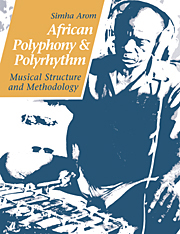Book contents
- Frontmatter
- Contents
- List of illustrations
- Foreword by György Ligeti
- Preface
- Acknowledgements
- BOOK I THE MUSIC OF THE CENTRAL AFRICAN REPUBLIC
- BOOK II AFRICAN POLYPHONIC MUSIC
- BOOK III TECHNICAL TOOLS: METHODS OF RECORDING POLYPHONIC MUSIC FOR TRANSCRIPTION
- 1 The need for transcription
- 2 The difficulties of transcription
- 3 Earlier methods
- 4 Towards a new method
- 5 Theoretical assumptions
- 6 Technical equipment: description and use
- 7 From recording to transcription
- 8 Checking the results
- 9 Potentialities
- 10 Anthropological validity
- BOOK IV THEORETICAL TOOLS
- BOOK V THE ORGANISATION OF TIME IN AFRICAN MUSIC
- BOOK VI STRUCTURAL PRINCIPLES AND THEIR APPLICATION
- Conclusion
- Bibliography
7 - From recording to transcription
Published online by Cambridge University Press: 27 January 2010
- Frontmatter
- Contents
- List of illustrations
- Foreword by György Ligeti
- Preface
- Acknowledgements
- BOOK I THE MUSIC OF THE CENTRAL AFRICAN REPUBLIC
- BOOK II AFRICAN POLYPHONIC MUSIC
- BOOK III TECHNICAL TOOLS: METHODS OF RECORDING POLYPHONIC MUSIC FOR TRANSCRIPTION
- 1 The need for transcription
- 2 The difficulties of transcription
- 3 Earlier methods
- 4 Towards a new method
- 5 Theoretical assumptions
- 6 Technical equipment: description and use
- 7 From recording to transcription
- 8 Checking the results
- 9 Potentialities
- 10 Anthropological validity
- BOOK IV THEORETICAL TOOLS
- BOOK V THE ORGANISATION OF TIME IN AFRICAN MUSIC
- BOOK VI STRUCTURAL PRINCIPLES AND THEIR APPLICATION
- Conclusion
- Bibliography
Summary
The method we have described is based on collecting culturally relevant documents. The musicians play their traditional instruments, the proper order of entry for each piece is respected, and temporal reference points are materialised according to internal criteria, such as superposition of the beat by the musicians themselves (an entirely immanent criterion from the cultural standpoint), rather than external ones, such as the use of a metronome or other chronometric systems involving the use of mechanical apparatus. With only material of this kind available, the transcription will have to depend on the musicologist's ear alone, rather than on instruments for measuring pitch and duration on a scale of discrete frequencies.
The method of transcription itself is based on the same theoretical assumptions as the recording method, but works in the opposite direction. It aims to reconstitute the entire piece in writing as a synthesis of the separate parts collected in the field by the recording method, which allowed us to ‘take the music apart’ into a temporal sequence of elements.
The first step in transcription is to organise the durational reference points. Extremely useful for this purpose is lined music paper which is also graduated with fine vertical lines. These can be used to show the arithmetic ratio of the durations: a given number of lines will mark the duration between two isochronous pulsations, which can be represented, for example, as a crotchet or a dotted crotchet, depending on whether the basic value contains a binary or a ternary division. We then prepare a strip of such paper long enough to hold a representative fragment of the piece, and with as many staffs as there are parts.
The first part may then be transcribed from the recording with the superposed beat.
- Type
- Chapter
- Information
- African Polyphony and PolyrhythmMusical Structure and Methodology, pp. 113 - 114Publisher: Cambridge University PressPrint publication year: 1991



